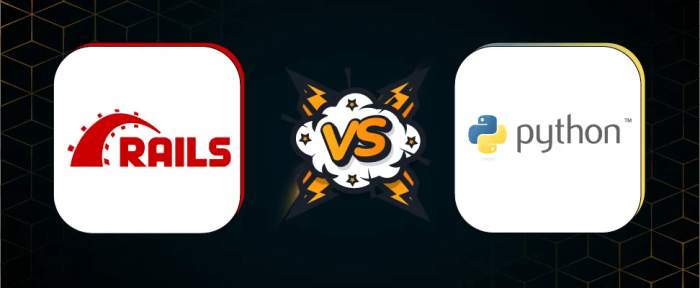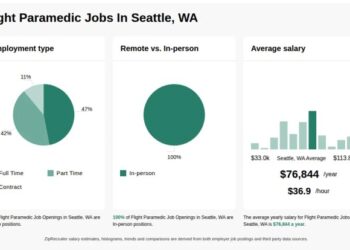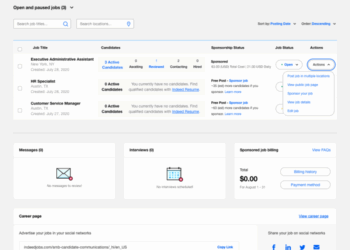When it comes to choosing between Ruby on Rails and Python developers, the decision can greatly impact the success of your project. Let's dive into the key differences and strengths of each language to help you make an informed choice.
Introduction
Ruby on Rails and Python are two popular programming languages used for web development. Ruby on Rails, often referred to as Rails, is a web application framework written in Ruby language. Python, on the other hand, is a versatile and easy-to-learn programming language known for its readability and simplicity.
Brief History
Ruby on Rails was created by David Heinemeier Hansson in 2004 and was released as open-source software. It gained popularity due to its convention over configuration principle, which emphasizes productivity and simplicity in coding.
Python, on the other hand, was developed by Guido van Rossum in the late 1980s and was released in 1991. It has since become one of the most widely used programming languages across various domains, including web development, data science, and artificial intelligence.
Importance of Choosing the Right Developer
Choosing the right developer is crucial for a project's success as they play a significant role in determining the efficiency, scalability, and maintainability of the software. A skilled developer with expertise in either Ruby on Rails or Python can ensure the project is completed on time, within budget, and meets the desired functionality.
Skill Comparison

When comparing the skills required for Ruby on Rails developers versus Python developers, it's essential to consider the unique strengths of each language in terms of web development. Additionally, understanding the differences in the learning curve for developers new to each language is crucial for making informed hiring decisions.
Ruby on Rails Developers
Ruby on Rails developers are known for their proficiency in building web applications rapidly. They have a strong grasp of the Ruby programming language and the Rails framework. Some key skills required for Ruby on Rails developers include:
- Proficiency in Ruby programming language
- Knowledge of Rails framework
- Experience with database management using ActiveRecord
- Understanding of RESTful web services
- Ability to work with front-end technologies like HTML, CSS, and JavaScript
Python Developers
Python developers, on the other hand, are valued for their versatility and readability of code. They are adept at backend development, data analysis, machine learning, and more. Some key skills required for Python developers include:
- Proficiency in Python programming language
- Experience with web frameworks like Django or Flask
- Knowledge of database management using libraries like SQLAlchemy
- Ability to work with data structures and algorithms
- Understanding of testing frameworks like Pytest
Learning Curve
In terms of the learning curve, Ruby on Rails is often considered more beginner-friendly due to its convention over configuration principle. This means developers can quickly get started with building web applications without having to configure every detail. On the other hand, Python, while known for its readability and simplicity, may have a steeper learning curve for beginners due to its flexibility and extensive use cases in various domains beyond web development.
Industry Applications
When it comes to choosing between Ruby on Rails and Python developers, it's essential to consider the industries where each technology is typically preferred. Let's explore the specific sectors that lean towards hiring Ruby on Rails developers and those that often opt for Python developers.
Ruby on Rails Developers
Ruby on Rails is commonly favored by industries that require rapid development and a focus on convention over configuration. Some of the sectors that often prefer hiring Ruby on Rails developers include:
- Startups: Ruby on Rails is popular among startups due to its ability to quickly build and iterate on minimum viable products.
- E-commerce: Many e-commerce platforms such as Shopify and Etsy are built using Ruby on Rails for its scalability and ease of use.
- Social Networking: Platforms like Twitter were initially built using Ruby on Rails, showcasing its capabilities in handling large volumes of data.
Python Developers
Python, on the other hand, is a versatile language that is widely used across various industries. Some sectors that often lean towards hiring Python developers include:
- Data Science and Machine Learning: Python's extensive libraries and frameworks make it a top choice for data analysis and machine learning projects.
- Web Development: Python frameworks like Django and Flask are popular for building web applications with clean and maintainable code.
- Scientific Computing: Industries such as academia and research heavily rely on Python for scientific computing and data visualization.
Successful Projects
Both Ruby on Rails and Python have been used in numerous successful projects across different industries. Some examples include:
- Ruby on Rails: Airbnb, Hulu, and Basecamp are just a few of the successful platforms built using Ruby on Rails.
- Python: Instagram, Spotify, and Dropbox are prime examples of successful projects that leverage Python for their backend infrastructure.
Performance and Scalability
When comparing Ruby on Rails and Python in terms of performance and scalability, it is essential to consider how each technology handles high traffic loads and complex functionalities.
Performance Benchmarks
- Ruby on Rails: Ruby on Rails is known for its slower performance compared to Python. This is mainly due to the language's dynamic nature and the way it handles certain tasks. However, with proper optimization and caching techniques, performance can be improved.
- Python: Python, on the other hand, is generally faster than Ruby on Rails in terms of performance. Its simplicity and readability contribute to its efficiency, making it a preferred choice for applications where speed is crucial.
Scalability Challenges
- Ruby on Rails: One of the scalability challenges faced by Ruby on Rails is its monolithic architecture, which can make it more difficult to scale as the application grows. Additionally, the framework's convention over configuration approach may limit flexibility in certain scaling scenarios.
- Python: Python's scalability largely depends on the chosen framework and architecture. While Python itself is relatively scalable, the design decisions made during development can impact how well the application scales. Asynchronous programming and microservices architecture can help address scalability challenges in Python applications.
Handling High Traffic Loads
- Ruby on Rails: Ruby on Rails can struggle with high traffic loads due to its slower performance compared to Python. To handle heavy traffic, developers can implement caching strategies, optimize database queries, and utilize background processing for resource-intensive tasks.
- Python: Python's faster performance makes it better equipped to handle high traffic loads. By leveraging asynchronous programming with frameworks like Django Channels or using load balancers and caching mechanisms, Python applications can efficiently manage increased traffic without sacrificing performance.
Community and Support
When it comes to choosing a programming language for a development project, the size and activity of the community behind it can play a crucial role. Community support can provide developers with resources, tools, and solutions to overcome challenges and streamline their workflow.
Let's compare the Ruby on Rails and Python communities to understand how they can impact the success of a project.
Ruby on Rails Community
The Ruby on Rails community is known for its strong sense of collaboration and support. Developers in this community actively contribute to open-source projects, share knowledge through forums and blogs, and participate in meetups and conferences. This vibrant community has led to the creation of numerous resources, libraries, and frameworks that make development faster and more efficient.
One of the most popular resources in the Ruby on Rails ecosystem is the RubyGems repository, which hosts thousands of gems (libraries) that can be easily integrated into projects.
Python Community
Python also boasts a large and active community that is known for its inclusivity and diversity. The Python community is spread across various online platforms, such as Stack Overflow, Reddit, and GitHub, where developers can seek help, share ideas, and collaborate on projects.
Python's extensive standard library and the availability of third-party libraries like NumPy, Pandas, and TensorFlow make it a versatile choice for developers working on a wide range of projects.
Impact on Development Projects
The size and activity of a programming community can significantly impact the success of a development project. A robust community means developers have access to a wealth of resources, expertise, and support when encountering challenges or seeking innovative solutions. By being part of a thriving community, developers can stay updated on the latest trends, best practices, and tools in their respective ecosystems.
Ultimately, community support can enhance the efficiency, quality, and overall success of a development project.
Cost Considerations
When it comes to hiring developers for your project, cost considerations play a crucial role in decision-making. Let's break down the cost implications of hiring Ruby on Rails developers versus Python developers and explore average salaries in each language.
Average Salaries
- Ruby on Rails developers: The average salary for a Ruby on Rails developer ranges from $70,000 to $110,000 per year, depending on experience and location.
- Python developers: Python developers typically earn an average salary between $80,000 to $120,000 annually, with variations based on skill level and geographic location.
Budget Considerations
- Projects using Ruby on Rails: When budgeting for a project using Ruby on Rails, it's essential to consider the hourly rates of developers, which can range from $75 to $150 per hour. Additionally, the cost of maintenance and updates should be factored in for ongoing expenses.
- Projects using Python: For projects utilizing Python, budget considerations should include developer rates averaging between $80 to $160 per hour. It's important to account for any additional costs related to third-party integrations or support services.
Final Conclusion
In conclusion, understanding the nuances between Ruby on Rails and Python developers is essential for finding the right fit for your project. By weighing the skills, industry applications, performance, community support, and cost factors, you can make a well-informed decision.
FAQ Compilation
What are the key skills required for Ruby on Rails developers compared to Python developers?
Answer: Ruby on Rails developers typically excel in rapid development and convention over configuration, while Python developers are known for their readability and versatility in various applications.
Which industries usually prefer Ruby on Rails developers over Python developers?
Answer: Ruby on Rails developers are often favored in e-commerce, social networking, and content management industries for their robust framework.
How do Ruby on Rails and Python differ in terms of performance and scalability?
Answer: Ruby on Rails may face challenges in scalability compared to Python due to its monolithic architecture, while Python's flexibility allows for better scalability in certain scenarios.
Are there significant differences in community support between Ruby on Rails and Python?
Answer: Python has a larger and more diverse community compared to Ruby on Rails, offering a wider range of resources, libraries, and frameworks for developers.
What are some cost considerations when hiring Ruby on Rails developers versus Python developers?
Answer: Ruby on Rails developers tend to have higher average salaries compared to Python developers, which can affect project budgeting and resource allocation.
When it comes to choosing between Ruby on Rails and Python developers, the decision can greatly impact the success of your project. Let's dive into the key differences and strengths of each language to help you make an informed choice.
Introduction
Ruby on Rails and Python are two popular programming languages used for web development. Ruby on Rails, often referred to as Rails, is a web application framework written in Ruby language. Python, on the other hand, is a versatile and easy-to-learn programming language known for its readability and simplicity.
Brief History
Ruby on Rails was created by David Heinemeier Hansson in 2004 and was released as open-source software. It gained popularity due to its convention over configuration principle, which emphasizes productivity and simplicity in coding.
Python, on the other hand, was developed by Guido van Rossum in the late 1980s and was released in 1991. It has since become one of the most widely used programming languages across various domains, including web development, data science, and artificial intelligence.
Importance of Choosing the Right Developer
Choosing the right developer is crucial for a project's success as they play a significant role in determining the efficiency, scalability, and maintainability of the software. A skilled developer with expertise in either Ruby on Rails or Python can ensure the project is completed on time, within budget, and meets the desired functionality.
Skill Comparison

When comparing the skills required for Ruby on Rails developers versus Python developers, it's essential to consider the unique strengths of each language in terms of web development. Additionally, understanding the differences in the learning curve for developers new to each language is crucial for making informed hiring decisions.
Ruby on Rails Developers
Ruby on Rails developers are known for their proficiency in building web applications rapidly. They have a strong grasp of the Ruby programming language and the Rails framework. Some key skills required for Ruby on Rails developers include:
- Proficiency in Ruby programming language
- Knowledge of Rails framework
- Experience with database management using ActiveRecord
- Understanding of RESTful web services
- Ability to work with front-end technologies like HTML, CSS, and JavaScript
Python Developers
Python developers, on the other hand, are valued for their versatility and readability of code. They are adept at backend development, data analysis, machine learning, and more. Some key skills required for Python developers include:
- Proficiency in Python programming language
- Experience with web frameworks like Django or Flask
- Knowledge of database management using libraries like SQLAlchemy
- Ability to work with data structures and algorithms
- Understanding of testing frameworks like Pytest
Learning Curve
In terms of the learning curve, Ruby on Rails is often considered more beginner-friendly due to its convention over configuration principle. This means developers can quickly get started with building web applications without having to configure every detail. On the other hand, Python, while known for its readability and simplicity, may have a steeper learning curve for beginners due to its flexibility and extensive use cases in various domains beyond web development.
Industry Applications
When it comes to choosing between Ruby on Rails and Python developers, it's essential to consider the industries where each technology is typically preferred. Let's explore the specific sectors that lean towards hiring Ruby on Rails developers and those that often opt for Python developers.
Ruby on Rails Developers
Ruby on Rails is commonly favored by industries that require rapid development and a focus on convention over configuration. Some of the sectors that often prefer hiring Ruby on Rails developers include:
- Startups: Ruby on Rails is popular among startups due to its ability to quickly build and iterate on minimum viable products.
- E-commerce: Many e-commerce platforms such as Shopify and Etsy are built using Ruby on Rails for its scalability and ease of use.
- Social Networking: Platforms like Twitter were initially built using Ruby on Rails, showcasing its capabilities in handling large volumes of data.
Python Developers
Python, on the other hand, is a versatile language that is widely used across various industries. Some sectors that often lean towards hiring Python developers include:
- Data Science and Machine Learning: Python's extensive libraries and frameworks make it a top choice for data analysis and machine learning projects.
- Web Development: Python frameworks like Django and Flask are popular for building web applications with clean and maintainable code.
- Scientific Computing: Industries such as academia and research heavily rely on Python for scientific computing and data visualization.
Successful Projects
Both Ruby on Rails and Python have been used in numerous successful projects across different industries. Some examples include:
- Ruby on Rails: Airbnb, Hulu, and Basecamp are just a few of the successful platforms built using Ruby on Rails.
- Python: Instagram, Spotify, and Dropbox are prime examples of successful projects that leverage Python for their backend infrastructure.
Performance and Scalability
When comparing Ruby on Rails and Python in terms of performance and scalability, it is essential to consider how each technology handles high traffic loads and complex functionalities.
Performance Benchmarks
- Ruby on Rails: Ruby on Rails is known for its slower performance compared to Python. This is mainly due to the language's dynamic nature and the way it handles certain tasks. However, with proper optimization and caching techniques, performance can be improved.
- Python: Python, on the other hand, is generally faster than Ruby on Rails in terms of performance. Its simplicity and readability contribute to its efficiency, making it a preferred choice for applications where speed is crucial.
Scalability Challenges
- Ruby on Rails: One of the scalability challenges faced by Ruby on Rails is its monolithic architecture, which can make it more difficult to scale as the application grows. Additionally, the framework's convention over configuration approach may limit flexibility in certain scaling scenarios.
- Python: Python's scalability largely depends on the chosen framework and architecture. While Python itself is relatively scalable, the design decisions made during development can impact how well the application scales. Asynchronous programming and microservices architecture can help address scalability challenges in Python applications.
Handling High Traffic Loads
- Ruby on Rails: Ruby on Rails can struggle with high traffic loads due to its slower performance compared to Python. To handle heavy traffic, developers can implement caching strategies, optimize database queries, and utilize background processing for resource-intensive tasks.
- Python: Python's faster performance makes it better equipped to handle high traffic loads. By leveraging asynchronous programming with frameworks like Django Channels or using load balancers and caching mechanisms, Python applications can efficiently manage increased traffic without sacrificing performance.
Community and Support
When it comes to choosing a programming language for a development project, the size and activity of the community behind it can play a crucial role. Community support can provide developers with resources, tools, and solutions to overcome challenges and streamline their workflow.
Let's compare the Ruby on Rails and Python communities to understand how they can impact the success of a project.
Ruby on Rails Community
The Ruby on Rails community is known for its strong sense of collaboration and support. Developers in this community actively contribute to open-source projects, share knowledge through forums and blogs, and participate in meetups and conferences. This vibrant community has led to the creation of numerous resources, libraries, and frameworks that make development faster and more efficient.
One of the most popular resources in the Ruby on Rails ecosystem is the RubyGems repository, which hosts thousands of gems (libraries) that can be easily integrated into projects.
Python Community
Python also boasts a large and active community that is known for its inclusivity and diversity. The Python community is spread across various online platforms, such as Stack Overflow, Reddit, and GitHub, where developers can seek help, share ideas, and collaborate on projects.
Python's extensive standard library and the availability of third-party libraries like NumPy, Pandas, and TensorFlow make it a versatile choice for developers working on a wide range of projects.
Impact on Development Projects
The size and activity of a programming community can significantly impact the success of a development project. A robust community means developers have access to a wealth of resources, expertise, and support when encountering challenges or seeking innovative solutions. By being part of a thriving community, developers can stay updated on the latest trends, best practices, and tools in their respective ecosystems.
Ultimately, community support can enhance the efficiency, quality, and overall success of a development project.
Cost Considerations
When it comes to hiring developers for your project, cost considerations play a crucial role in decision-making. Let's break down the cost implications of hiring Ruby on Rails developers versus Python developers and explore average salaries in each language.
Average Salaries
- Ruby on Rails developers: The average salary for a Ruby on Rails developer ranges from $70,000 to $110,000 per year, depending on experience and location.
- Python developers: Python developers typically earn an average salary between $80,000 to $120,000 annually, with variations based on skill level and geographic location.
Budget Considerations
- Projects using Ruby on Rails: When budgeting for a project using Ruby on Rails, it's essential to consider the hourly rates of developers, which can range from $75 to $150 per hour. Additionally, the cost of maintenance and updates should be factored in for ongoing expenses.
- Projects using Python: For projects utilizing Python, budget considerations should include developer rates averaging between $80 to $160 per hour. It's important to account for any additional costs related to third-party integrations or support services.
Final Conclusion
In conclusion, understanding the nuances between Ruby on Rails and Python developers is essential for finding the right fit for your project. By weighing the skills, industry applications, performance, community support, and cost factors, you can make a well-informed decision.
FAQ Compilation
What are the key skills required for Ruby on Rails developers compared to Python developers?
Answer: Ruby on Rails developers typically excel in rapid development and convention over configuration, while Python developers are known for their readability and versatility in various applications.
Which industries usually prefer Ruby on Rails developers over Python developers?
Answer: Ruby on Rails developers are often favored in e-commerce, social networking, and content management industries for their robust framework.
How do Ruby on Rails and Python differ in terms of performance and scalability?
Answer: Ruby on Rails may face challenges in scalability compared to Python due to its monolithic architecture, while Python's flexibility allows for better scalability in certain scenarios.
Are there significant differences in community support between Ruby on Rails and Python?
Answer: Python has a larger and more diverse community compared to Ruby on Rails, offering a wider range of resources, libraries, and frameworks for developers.
What are some cost considerations when hiring Ruby on Rails developers versus Python developers?
Answer: Ruby on Rails developers tend to have higher average salaries compared to Python developers, which can affect project budgeting and resource allocation.











